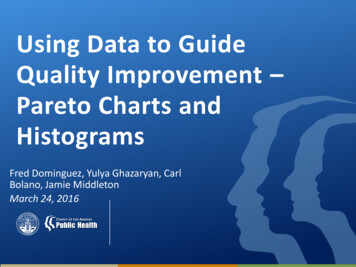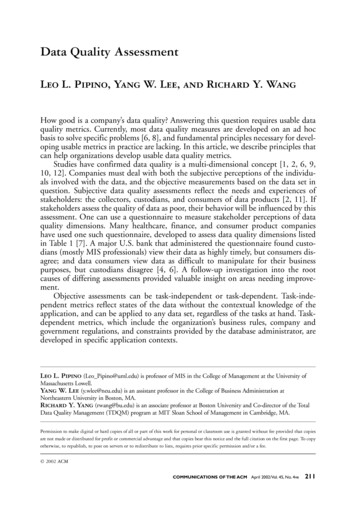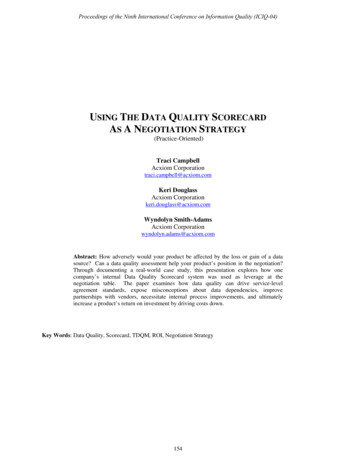
Transcription
Using Data to GuideQuality Improvement –Pareto Charts andHistogramsFred Dominguez, Yulya Ghazaryan, CarlBolano, Jamie MiddletonMarch 24, 2016
Seven Basic Tools of Quality Cause-and-effect diagram (aka "fishbone" or Ishikawa diagram) Check sheet Control chart Histogram Pareto chart Scatter diagram Stratification (aka flow chart or run chart)Tague, NR The Quality Toolbox, Second Edition, ASQ Quality Press, 2005, pg 15
Today’s Goals & ObjectivesGOALS Brief Overview of Histogram (p52) & Pareto Chart(p80) Group exercise: Example scenario utilizing each tool Review StoryboardOBJECTIVES General understanding of Historgrams and ParetoCharts How to create and interpret each
HISTOGRAM
What is a Histogram? Graph used to show the frequency of occurrence of differentvalues:– X-axis or horizontal axis represents the values present in the data– Y-axis (and thus the height of each bar) represents the frequency ofoccurrence of that value or range of values Histograms allow a team to:– Display large amounts of data in visual format– Show relative frequency of various data values– Illustrate underlying distribution of the data– Reveal the shape and variation of the data– Provide information for predicting future performance5
HISTOGRAM – WHY IT IS USEDHISTOGRAM - intervalsBAR GRAPH – categoriesHow Many Apples Do People Eat EachWeekFruit Purchased at the Market180160120160100140100120Number of esBananas5-910-14Average number of Apples Eaten Weekly
Characteristics of data detected by histograms7
How to Construct a Histogram1.2.3.4.5.Decide on the indicator to be measuredCollect a large number of data pointsPrepare a frequency table from the dataGroup the data into intervalsPlot/Create the histogram8
Creating a Histogram - ExampleAge RangePercentages of actresses20-25 25-3072330-352735-401840-45945-50 5-6060-65565-7070-75 75-80 80-8511
HISTOGRAM VIDEO https://www.youtube.com/watch?v jFqRECGWAcM
ParetoCharts
What is a Pareto Chart? A Pareto chart helps a team focus on problems that offer thegreatest potential for improvement, by showing differentproblems' relative frequency or size in a descending bar graph,which highlights the problems' cumulative impact. Teams can then focus on problem causes that could have thegreatest impact if solved or improved. The Pareto principle: 20% of sources cause 80% of problems.
Why is a Pareto Chart Used? Contains both bars and a line graph - individual valuesare represented in descending order by bars, and thecumulative total is represented by the line– The left vertical axis (y-axis) is the frequency of occurrence– The (y-axis) right vertical axis is the cumulative percentage of the totalnumber of occurrences, total cost, or total of the particular unit ofmeasure– The x-axis (horizontal) is the list of units, potential causes, etc. that you aremeasuring The purpose of the Pareto chart is to highlight the mostimportant among a (typically large) set of factors
How to Construct a Pareto Chart1.2.3.4.Choose Problem, Potential CausesChoose Measurement UnitsGather DataConstruct Pareto Chart
How we can use a Pareto Chart - g-changes/
Pareto Chart Video https://youtu.be/HwTSnkBWaHM
Self Assessment QuestionsMost common purpose(s) for using a histogram is/are:A. Show distributionB. how often each different value in a set of data occursC. which factors are more significantD. look for a relationshipE. A & BF. A & DG. All the above
Self Assessment QuestionsMost common purpose(s) for using a histogram is/are:A. Show distributionB. how often each different value in a set of data occursC. which factors are more significantD. look for a relationshipE. A & BF. A & DG. All the above
Self Assessment QuestionsMost common purpose(s) for using a Pareto chart is/are:A. problems' cumulative impactB. contains an ordered bar chartC. contains a line graphD. summarizes where opportunity liesE. A & BF. A, B, &CG. All the above
Self Assessment QuestionsMost common purpose(s) for using a Pareto chart is/are:A. problems' cumulative impactB. contains an ordered bar chartC. contains a line graphD. summarizes where opportunity liesE. A & BF. A, B, &CG. All the above
GROUPEXERCISES
DPH - Employees Absenteeism During Flu Season (Dec - March 2015)DPH DivDivision 1Division 2Division 3Division 4Division 5Division 6Division 7Division 8Division 9Division 10Division 713137240%Days .9%100.0%
Histogram 1: Create a Histogram for Total N Sick DaysTotal Number of Sick Days for DPH Employees during the Flu n 1 Division 2 Division 3 Division 4 Division 5 Division 6 Division 7 Division 8 Division 9 Division 10 Division 11
Histogram 1: Create a Histogram for Total % Sick DaysPercent of Sick Days for Employees during Flu Season (N 240 on 1 Division 2 Division 3 Division 4 Division 5 Division 6 Division 7 Division 8 Division 9 Division 10Division 11
2: Pareto Chart – Hypothetical Problem DescriptionScenario: (Hypothetical)Problem: Based on the recent internal departmental time sheet data analysis, DPHEmployee absenteeism during the Flu Season has significantly increased during theperiod from December 2014 to March 2015. Most of the time employees were outsick due to a widespread flu. As a requirement, all DPH employees are mandated tohave their Flu Vaccinations by Dec 1, 2014 and report statistics of employees whoreceived and declined flu vaccinations to the Nurse Administration.Task:Based on information provided to you, please review some basic (hypothetical) statsof DPH Employee Flu Vaccination Status as of Dec 1, 2014 for DPH 11 Divisions andcreate Pareto Charts in order to identify the where the problem is.
Exercise 2: Pareto ChartGroup Exercise 1:Task: Create a Pareto Chart for the Percent of Employees who Declined FluVaccine. Where is the problem?Group Exercise 2:Task: Create a Pareto Chart for the Percent of Employees who Received FluVaccine. Where is the problem?Group Exercise 3:Task: Create a Pareto Chart for the reasons for declining flu vaccination.Where is the Problem? How can you affect it?
STORY BOARDReduction in Percentage of Clients withCycle Times Greater than 2 Hours in aFamily Planning Clinic
Story Board – Figure 1
Story Board – Figure 2
Story Board – Figure 3
Story Board – Figure 4
Seven Basic Tools of Quality Cause-and-effect diagram (aka "fishbone" or Ishikawa diagram) Check sheet Control chart Histogram Pareto chart Scatter diagram Stratification (aka flow chart or run











